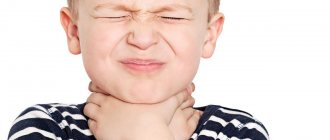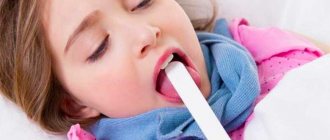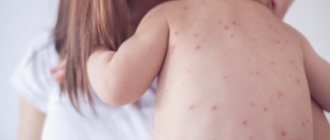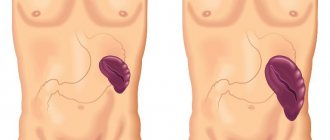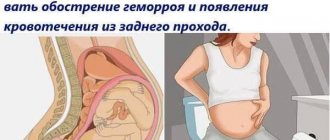Children very often suffer from sore throat. Before starting treatment, it is important to determine its type. The most common forms found in children are: catarrhal, purulent, lacunar, herpetic. Each of these types has certain similarities and its own characteristics. Today we will look at the symptoms and treatment of purulent tonsillitis in children at home.
At the back and sides of the throat are oval pieces of tissue called tonsils. They block the entry of any germs into the baby's body and also help in the production of antibodies that fight infections.
Tonsils play a crucial role in the body's immune defense, but sometimes they can become a victim of infections. When they are affected by germs or bacteria, they tend to swell and become covered with a whitish or yellowish coating, which causes them to become inflamed. This inflammatory disease is called purulent tonsillitis or tonsillitis.
Tonsillitis is contagious and spreads easily from an infected child to other children. It can be transmitted by talking, sneezing, coughing and through touching furnishings, dishes, and dirty linen. Hugs and kisses are also a guaranteed way to transmit infection.
Basically, this infection spreads among children in the community (school) and at home (family members).
Description of the disease
In medicine, it is also known as acute tonsillitis, and is one of the most common diseases of the upper respiratory tract. Sore throat in a child, as well as in an adult, is an inflammation that occurs in the tonsils of the palate (tonsils) and is of infectious origin.
The mechanism of the disease is that pathogenic microorganisms are able to penetrate the oral cavity, colliding with the tonsils. They, in turn, act as one of the components of the lymphatic system, which is designed to ensure the safety of the body, so they try to resist infection. The tonsils do this by producing antibodies that should eliminate harmful microorganisms. But in some cases, children's immunity cannot fully fight them, and then an inflammatory process develops in the tonsils, and they themselves become the object of infection.
If this happens, the onset of the disease may be accompanied by the following processes:
- Swelling of the affected tissues;
- The appearance of purulent mucous discharge;
- Intoxication.
Types and forms of acute tonsillitis
Based on their origin, the following types of sore throats are distinguished:
- primary (banal) – self-developing acute inflammation;
- secondary (symptomatic) – develop against the background of measles, diphtheria and other infections, with diseases of the hematopoietic system (agranulocytosis, acute leukemia, infectious mononucleosis);
- specific - occur with specific infectious inflammations (ulcerative membranous tonsillitis, fungal tonsillitis).
According to the nature of the lesions of the tonsils, tonsillitis is distinguished:
- catarrhal;
- lacunar;
- follicular;
- fibrinous;
- phlegmonous.
The catarrhal form occurs without suppuration. Other forms of sore throats are classified as purulent inflammations.
Symptoms of a sore throat
In a child, they usually have a more intense manifestation compared to the course of the disease in adults. You can notice that he is not feeling well by indirect signs - moodiness, anxiety, causeless (at first glance) crying, loss of appetite. The fact that this particular disease has overtaken him will be indicated by the symptoms of a sore throat in a child, which are as follows:
- The presence of pain during swallowing;
- General weakness;
- Severe pain in the throat;
- Redness of the mucous membrane;
- Body temperature with angina usually rises, reaching 37.2-39, and sometimes 40 degrees;
- The appearance of a cough, a sore throat;
- Pain in the ears;
- It is possible that the lymph nodes located under the lower jaw are enlarged.
If a sore throat develops in a child 3 years of age or less, in such cases signs of intoxication of the body are more often expressed, manifested by nausea, vomiting, bad breath, and the development of rhinitis (the appearance of nasal discharge). However, symptoms of intoxication can make themselves felt at any age, including if an adult is sick.
Video “Doctor Komarovsky about sore throat”
Purulent tonsillitis in children: features of the disease, treatment and other nuances through the eyes of Dr. Komarovsky. This is exactly what you can learn from the video.
Do you have any questions? Specialists and readers of the KROHABABY website will help you ask a question
Was this article helpful?
Thank you for your opinion!
The article was useful. Please share the information with your friends.
Yes (100.00%)
No
X
Please write what is wrong and leave recommendations on the article
Cancel reply
Rate the benefit of the article: Rate the author ( 2 votes, average: 5.00 out of 5)
Discuss the article:
Types of sore throat in children
They are determined depending on the symptoms, severity, duration of the disease, and they are as follows:
- Catarrhal. This is one of the mildest and most common forms of the disease. It affects the surface of the tonsils, accompanied by redness and swelling. Often catarrhal tonsillitis is a concomitant disease against the background of other types of respiratory tract diseases. Catarrhal tonsillitis in a child does not have very pronounced symptoms. The body temperature with it can be 37.2-38 degrees, pain is often characterized by moderate intensity, as well as soreness and pain when swallowing. The little patient usually recovers within a week;
- Follicular. This type of pathology spreads to the follicles of the tonsils, and during an in-person examination, the doctor finds small yellowish or whitish purulent inclusions on them, having a diameter of about 1-2 mm. The signs of follicular tonsillitis are quite intense - body temperature can reach 38 degrees or more, pain in the throat is strong, the child cannot swallow painlessly, and salivation increases. When palpating the lymph nodes in the back of the head and neck, he feels pain;
- Lacunarnaya. In general, its symptoms are similar to those of follicular tonsillitis, but purulent inclusions form not on the follicles of the tonsils, but in the lacunae - the ducts of the tonsils. The clinical picture for this type of disease is as intense as in the previous case;
- Fungal. This form of pathology is accompanied by redness and a slight enlargement of the tonsils, increased body temperature, which can be 37.2-37.5 degrees. The main symptom of this type of disease is the appearance of plaque on the affected area, which has a cheesy consistency and bright white color, and is easily removed from the tonsil tissue;
- Herpetic. This type of disease is also known as herpes sore throat in a child. Its provocateur is the Coxsackie virus of the enterovirus family. Its danger lies in the fact that it may not be limited to damage to the tonsils - it can also affect muscle tissue and nerve cells, which means that the disease can develop, affecting other organs. Herpes sore throat is accompanied by the formation of multiple rashes on the tonsils in the form of blisters filled with colorless liquid. It is possible that small ulcers may form in the affected area;
- Ulcerative-necrotic. This is the most severe type of disease, in which areas of dead tissue form on the tonsils. When they separate over time, ulcers appear in their place, which can be quite deep.
Often parents are faced with such a diagnosis as purulent tonsillitis in a child, and, of course, it scares them. They talk about it when lacunar or follicular tonsillitis is detected - two forms accompanied by the accumulation of purulent discharge on the tonsils. These types of pathologies are really difficult, causing serious discomfort and pain to the baby. As with the treatment of other varieties of this disease, it is important to promptly consult a doctor for help in order to prevent the disease from worsening.
What does a purulent sore throat look like?
There are 4 forms of sore throat:
Phlegmonous. The tissue of the tonsils is affected. One-sided defeat. Follicular. The lesion is located in the follicles of the tonsils. The latter have small abscesses. Fibrinous. Pus is spread over the entire surface of the soft palate. Often loss of consciousness, objectively – shortness of breath. Lacunarnaya. Pus enters the lacunae due to flow from the follicles. The lesion is not located in a specific area, but looks like a plaque.
Causes of sore throat in children
The disease, depending on its origin, can be viral or bacterial. The second option accounts for about 90% of all its cases. The most common causative agent of the disease is beta-hemolytic streptococcus, and in approximately 20% of cases the causative agent of the pathology is a combination of staphylococcus and streptococcus. In the youngest patients, the disease is often caused by viruses, which include:
- Cytomegalovirus;
- Adenovirus;
- Herpes;
- Respiratory syncytial virus;
- Epstein-Barr viruses.
Children over 5 years of age more often suffer from tonsillitis of bacterial origin, caused by streptococcus, staphylococcus, spirochete, pneumococcus. The infection is transmitted by airborne droplets or household contact.
Normally, the child’s body should be ready to overcome it, preventing the development of the disease, but in some cases the immune system fails, which often happens if a sore throat is diagnosed in a child 2 years of age, but also at an older age, including adults , this can happen too.
The child’s body’s defenses can be weakened for a number of reasons:
- Hypothermia;
- Poor nutrition that lacks balance;
- Frequent colds;
- Lack of vitamins, micro-, macroelements in the body;
- Stress;
- Prolonged stay in polluted air;
- Excessive stress - both physical and mental.
The cause of the development of the disease can also be the presence of chronic inflammation in the body, and therefore a source of infection. For example, it could be sinusitis, caries.
Causes
Tonsillitis in a child can be caused by:
- Viruses (the main cause of sore throat in children 2-3 years old):
- Coxsackie,
- herpes,
- adenoviruses,
- flu,
- picornaviruses,
- enteroviruses.
- Fungi:
- Candida,
- Leptotryx.
- Bacteria:
- streptococci,
- spirochetes,
- Loeffler's bacillus
- diplococci,
- staphylococci,
- gonococci.
Viruses
With weakened immunity, a person becomes susceptible to the effects of pathogenic viruses. They enter the baby’s body through the mouth (children often lick toys, dirty fingers, and even eat soil or snow) and are embedded in the lymphoid tissue of the tonsils. Most often, the peak of viral diseases occurs in autumn or spring. It is during this period that people eat little fresh vegetables and fruits and spend less time outdoors due to bad weather.
Fungi
In children, mycotic tonsillitis is most often caused by Candida fungi. Most often, they exist safely on the mucous membrane of the child’s oropharynx, but with weak immunity and diabetes mellitus they can cause tonsillitis.
Bacteria
Bacteria are normally present in any organism. As a rule, they do not have a pathogenic effect on the body, but with reduced immunity they become the cause of illness. Pathogens from the external environment also join a person’s own bacteria.
The most famous causative agent of bacterial tonsillitis is group A β-hemolytic streptococcus. It promotes serious changes in the tissue of the child’s tonsils. The microorganism produces a specific enzyme, streptokinase, which melts tissue and destroys immune cells.
Diagnosis of sore throat in children
You should not try to do it yourself, focusing on the identified symptoms - leave this task to a specialist. Moreover, it is necessary to contact him immediately upon noticing the first signs of a sore throat in a child. The doctor will determine not only the type of disease, but also its stage, and based on these factors, prescribe treatment.
First of all, the doctor will get acquainted with the complaints of the young patient and his parents, after which he will examine the oral cavity using pharyngoscopy or a laryngeal speculum, and palpate the lymph nodes. Based on the initial examination, the specialist will make a preliminary diagnosis, but it requires confirmation, for which he will prescribe additional diagnostic measures, including:
- Examination of a smear taken from the throat. With its help, the provocateur of the disease is determined and the level of sensitivity to antibacterial drugs is established;
- A blood test to detect whether the body has produced antibodies to the pathogen. If there is one, it is concluded that its cause is an infection.
In some cases, to clarify the clinical picture, the doctor may prescribe a general urine test. If the pathology is characterized by a complex course, it is possible that the patient will be referred for a CT or MRI.
How is childhood disease transmitted - signs
Tonsillitis is transmitted in all possible ways:
- Nutritional – infection through food. Milk and cottage cheese, which are not heat treated, are especially dangerous.
- Contact - through direct touching the patient, as well as when using his things and utensils. Therefore, during a sore throat, the patient is given personal utensils, and clothes and bed linen are washed as often as possible.
- Airborne - during sneezing, coughing, talking, some bacteria enter the air. This method of infection is the most common, which explains outbreaks of the disease in schools and kindergartens. You can learn about treating tonsillitis at home here.
There is another option for the appearance of sore throat - autoimmune. In this case, the source of inflammation becomes an untreated tooth, sinusitis, otitis media, and tonsillitis becomes a secondary disease.
General recommendations
They must be strictly observed so that the effectiveness of therapy is high, and in order to prevent infection of the disease to other children and adults (it is contagious).
- The child should be isolated, protecting him from visiting kindergarten or school, classes, walks, including spending time on playgrounds;
- The patient must remain in bed. In addition to the fact that he does not feel well during the period of illness, the temperature of a child with a sore throat is usually high, and rest, which the body needs to restore strength to fight the disease, will help to quickly eliminate this symptom;
- To quickly eliminate the causative agent of the disease, you should give the young patient plenty of fluids to drink. This could be warm tea, clean water, natural fruit drinks, compotes, etc.;
- It is necessary to organize proper nutrition for the baby, which will be discussed below.
If a small child has a sore throat, how to treat it correctly, what to do, first aid
Treatment of tonsillitis involves several mandatory measures:
- Drug therapy - drugs are prescribed to destroy the causative agent of the disease, as well as antipyretics and anti-allergenic drugs.
- Routine - children must remain in bed. This is a mandatory condition, since complications of sore throat are fraught with the development of heart disease.
- Local treatment - gargling, inhalation, irrigation, lubricating the tonsils.
- Diet - dishes that do not irritate the mucous membranes. Be sure to drink plenty of warm drinks.
At the first signs of tonsillitis, the child should be put to bed and given warm water and dried fruit compote. It is impossible to immediately give a liquid with an antipyretic effect, since its action will cause the baby to sweat a lot, which can lead to dehydration. Later they give tea with raspberry or currant jam.
If possible, it is worth applying a compress. It is undesirable to bring down a temperature that has not reached 39 C, unless we are talking about a two-year-old child. It is better to wipe the baby with a towel moistened with warm water and wrap him up again, and put a wet towel on his forehead. To reduce sore throat and sore throat, lozenges and lozenges are given.
You cannot decide on your own whether your child needs antibiotics. Until the causative agent of sore throat is determined - virus, bacteria, the use of medications is prohibited.
Medicines and throat medications
Treatment will require drugs against the causative agent of infection, to reduce the temperature, antihistamines, as well as to remove purulent plaque and relieve soreness from the throat. Medicines are prescribed by a doctor. The choice depends on too many factors to do without examination and analysis.
Antibiotic treatment regimen for purulent sore throat
For tonsillitis, antibiotics of 3 groups are prescribed:
- penicillins – Flemoxin solutab, amoxicillin;
- macrolides – Sumamed, Azithromycin;
- cephalosporins – Zinnat, Cefatoxime.
Price – 250 rubles
The drugs act on both gram-positive and gram-negative bacteria. The choice depends on whether the child has previously suffered from infectious diseases, and what drugs have already been used in treatment. Thus, drugs of the penicillin group quickly cease to be effective - the pathogen acquires resistance to them. In this case, drugs from the macrolide group are prescribed:
- Suprax - produced in the form of tablets, suspension and dispersed tablets. Children are prescribed only a suspension. Suprax granules are dissolved in 40 ml of water at a temperature of 30–40 C and stirred until a suspension is formed. Babies under 1 year old are given Suprax no more than 2.5–4 ml per day, children from 2 to 4 – 5 ml per day. From 5 years of age, the dosage is increased from 6 to 10 ml. You need to drink it at once. Suprax costs an average of 731 rubles.
- Sumamed - children from 6 months to 3 years are prescribed a suspension, older children - tablets. The dosage is calculated based on body weight: for a weight up to 14 kg, the dose is 2.5 ml per dose, for a weight up to 24 kg - 5 ml. If the weight has reached 34 kg, the volume is increased to 7.5, if 44 kg - 10 ml. Drink an antibiotic at one time. You should give a drink after taking the medicine to wash away its taste. The price of the suspension is 488 rubles, tablets – 350–383 rubles. If the baby is over 3 years old, he can take tablets. 1 capsule of Sumamed contains 125 mg of active substance. The dose is calculated based on weight: up to 30 kg - 2 pieces per day, up to 44 - 3. Treatment lasts no more than 3 days.
- Zinnat is an antibiotic from the cephalosporin group. It is used in the treatment of babies from 3 months. The dose of Zinnat is calculated by age: from 3 to 6 months - 2.5 ml per day, up to 2 years - 2.5-5 ml, up to 16 years - 5 ml. For severe purulent sore throat, the volume is increased: from 6 months to 2 years – 5–7.5 ml, from 2 to 16 – 7.5–10 ml. Treatment lasts 3–4 days for catarrhal form and up to 7 days for purulent complications. Cost 50 ml – 306 rub.
- Tsiprolet , an antibiotic, should not be taken by children under 15 years of age. Package price – 56 rubles.
- Flemoxin solutab is a drug from the penicillin group. Available in the form of absorbable tablets. The dose is calculated individually. From 2 to 5 years old, 125 mg of the drug is given, from 5 to 10 - 250 mg, over 10 - up to 500 mg. The antibiotic is taken every 8 hours. With a weight of less than 40 kg, the daily dose varies from 20 to 100 mg per 1 kg of weight. A package of 500 mg will cost 326 rubles.
The antibiotic acts quickly. If within 3 days the patient’s condition has not changed for the better, a drug of a different group is prescribed.
Antihistamines
Antiallergic drugs solve 2 problems: relieve swelling of the throat to alleviate the patient’s condition, and prevent the development of an allergic reaction. The body of a small child can react to medications in completely unpredictable ways:
- Suprastin - produced in tablet form. Prescribed from 3 years of age: from 3 to 6 – ½ capsule twice a day, from 6 to 14 – ½ capsule 2–3 times, and from 14 to 18 – 1 to 4 times a day. Reception begins with a minimum dose. Suprastin is taken with meals and must be washed down with water. Side effects are rare and disappear after cessation of treatment. Suprastin No. 40 costs 255 rubles.
- Cetrin is effective in the early stages of allergies, therefore it is suitable for preventing an allergic reaction when taking the medicine. Available in tablet form. The drug is prescribed from 6 years of age: ½ tablet twice a day or 1 pc. - 1 time. Cetrin extremely rarely provokes drowsiness, headache or dizziness. Price for 20 capsules – 170 rub.
- Claritin – recommended for seasonal, year-round and chronic allergies. It is prescribed from 2 years of age in the form of syrup and tablets. The volume of medication is calculated taking into account the body weight of patients from 2 to 12 years old. For those weighing up to 30 kg, take 5 mg - this is ½ tablet or a teaspoon of syrup, 1 time per day. With a weight of more than 30 kg - 10 mg 1 time. If the child suffers from liver problems, drink the indicated dose every other day. The cost of 60 ml of syrup is 268 rubles.
- Desal is a 3rd generation drug. Available in the form of solutions and tablets. Dosage depends on age. From 1 to 6 years old, 2.5 ml of Dezal solution is given, from 6 to 11, the dosage is increased to 5 ml at a time, a teenager over 11 needs up to 10 ml. According to research, a dose of even 45 ml is not dangerous for the child, but causes severe drowsiness. The medicine is taken once a day. 100 ml of solution will cost 298 rubles.
- Suprastinex - drops for oral administration or tablets. Prescribed from 6 years of age: 5 mg per day, that is, 1 capsule or 1 ml of liquid drug. A child from 2 to 6 is given only the liquid form - 5 drops twice a day. The dose is adjusted if the patient has impaired renal function. Take Suprastinex until the throat swelling disappears. You can buy 20 ml of Suprastinex for 365–445 rubles.
Antihistamines should be selected very carefully, as they interact differently with the main medications.
Antiviral for viral tonsillitis
If tonsillitis is caused by viruses, antibiotics are powerless. Therapy includes antiviral medications:
- Arbidol - suppresses group A and B viruses, as well as ARVI pathogens, paravirus, adenovirus and others. In addition, arbidol improves immunity. It is used in the treatment of childhood sore throat from 6 years of age - 100 mg per day, this is 1 capsule. From 12 pm 200 mg is prescribed. The number of doses depends on the severity of the disease: for a mild form, take 2 capsules, for a severe form, up to 4. Arbidol is taken before meals, since food slows down its absorption. Treatment takes 5–7 days. 20 capsules containing 100 mg of active substance cost 541 rubles.
- Cycloferon is available in the form of injections or tablets. The ampoule contains 125 mg of the active substance, and the tablet contains 150. Cycloferon does not affect viruses, but the immune system, stimulating the production of interferons. The latter destroy the causative agents of sore throat. The drug is prescribed to children at least 4 years of age. The fact is that the capsule cannot be crushed or dissolved in water to make it easier to take - it can only be swallowed. For a child from 4 to 6 years old, 1 piece per day is enough, from 6 to 11 they need 2-3 pieces per day, for schoolchildren over 12 - up to 4. Cycloferon is taken according to the scheme. Typically, you should take the medicine every day for the first 2 days, then every other day. The doctor develops the scheme. Price 20 capsules – 398 rub.
- Viferon is a human interferon that stimulates the synthesis of immunoglobulins. Viferon is produced only in the form of suppositories with different concentrations of the active substance. The drug is absolutely safe and is prescribed even to newborns, including premature babies. Use suppositories containing 150 thousand IU. Infants up to one year old are administered 1 suppository every 12 hours, from 1 to 7 - 1 suppository twice a day. Older children are treated according to the same scheme, but suppositories with a higher interferon content are used - 500 thousand IU. The course lasts no more than 5 days. If the need arises, treatment can be repeated after a break. Viferon 500 thousand IU is offered for 295 rubles.
- Kagocel – does not act directly on viruses, but stimulates the production of interferon. Kagocel is produced only in tablet form, therefore it is prescribed to children only from 3 years of age. Patients under 6 years of age drink 1 piece twice a day for the first 2 days, and 1 piece per day for the next two days. Schoolchildren take 1 three times a day on the first 2 days, and twice on the 3rd and 4th days. The course is 4 days. The cost of packaging is 10 pcs. – 218–225 rub.
- Ingavirin is an antiviral drug in tablets. In the children's version, the dose of the active substance is lower - 60 mg.
Price – about 200 rubles
Drugs that have an immunomodulatory effect can be prescribed together with antibiotics. They improve immunity weakened by the disease and prevent the development of chronic tonsillitis.
How to help a child with rinses for lacunar, how to remove plaque
With lacunar or fibrinous tonsillitis, a yellowish-white coating quickly appears on the tonsils. The film is formed by pus, released when festering follicles burst. It cannot be removed mechanically - hyperemic tonsils are too easy to damage. Get rid of film using various types of rinses:
- Hexoral - for sore throat, use a rinse solution and an aerosol. Immediately after eating, measure out 15 ml of medicinal liquid and rinse your mouth for 30 seconds. Perform the procedure twice a day. The aerosol is sprayed onto the tonsils 3 times a day. This form of Hexoral does not so much remove plaque as prevent the spread of the disease. The solution costs 367 rubles, aerosol – 397 rubles.
- Tantum Verde is a lozenge with a characteristic orange-honey flavor. They relieve sore throat, reduce soreness and have a specific antimicrobial effect. For angina, give 1 piece three times a day. Tantum Verde is not prescribed to patients under 6 years of age: the tablets are large and a small child may choke. Price 20 pieces – 315 rub.
- Furacilin - solution. The medicine has a pronounced antiseptic effect. Gargle with furatsilin for at least 3 minutes three times a day. The course lasts 3–5 days until the sore throat subsides and swelling disappears. The dosage does not depend on age, but only a sufficiently old child can perform the procedure. The cost of the drug is 150 rubles.
- Rotokan is a herbal preparation based on calendula, chamomile and yarrow. The solution is alcoholic, therefore it is prescribed to adolescents at least 12 years old. Add 5 ml of Rotokan to a glass of warm water and gargle with the resulting liquid. The procedure is repeated 2 to 4 times a day. Therapy lasts 3–5 days. The extract can be bought for 18-67 rubles.
- Miramistin is a solution that has an antimicrobial effect. Miramistin is used for rinsing for pharyngitis and sore throat - 10-15 ml per glass of water, and for irrigation - this requires a sprinkler attachment. This option is suitable for babies who cannot rinse. The procedures will be repeated 3-4 times a day. 50 ml of solution will cost 275 rubles.
Cost – about 300 rubles
Rinsing and irrigation are mandatory elements of treatment for tonsillitis. The tonsils are not only cleared of plaque, but also moisturized, which reduces inflammation. Rinsing is also indicated for ordinary catarrhal sore throat.
Local treatment
Swollen tonsils and palate cause soreness, a feeling of unpleasant squeezing, and pain when swallowing. Sometimes the swelling is so severe that it is difficult for a small patient to breathe. To get rid of inflammation and pain, local combination drugs are used. Aerosols, rinsing solutions, lozenges relieve inflammation, disinfect, thus destroying pathogenic microflora, moisturize the throat:
- Strepsils - yellow large tablets made of translucent caramel mass. They resemble children's lollipops and dissolve quickly. Relieves sore throat, sore throat, improves the condition of the vocal cords. The recommended dose is 1 piece every 3 hours, but not more than 8 per day. Strepsils is offered to children over 6 years old. Pack of 16 pcs. costs 210 rubles.
- Inhalipt is a universal antiseptic. It affects bacterial pathogens of tonsillitis, suppresses inflammation and has an analgesic effect. Inhalipt in the form of a spray is sprayed into the throat 3-4 times a day. You need to use the spray for 10 days. Spray price – 185 rub.
- Yox is a rinse solution containing povidone-iodine and allantoin. Mix ½ or 1 teaspoon of liquid with 100 ml of warm water and gargle with the composition. This should be done 2 to 4 times, maximum 6 times a day. Yox is included in therapy if a young patient already knows how to rinse his mouth, that is, from 6–7 years old. 50 ml of solution is offered for 226–285 rubles.
- Anti-Angin - based on chlorhexidine and ascorbic acid. These are dissolving tablets with mint flavor. They have a general analgesic effect and are active against gram-positive bacteria. Anti-Angin is given to children at least 5 years old - 3 pieces. in 4 hours. From 10 to 15 - 4 pieces, over 15 - up to 6. Cost of 12 lozenges - 186-185 rubles.
- Lyzobact - dispersible tablets based on pyridoxine and lysozyme hydrochlorides. The antiseptic is active against both bacteria and viruses, and stimulates local immunity. Lizobakt is prescribed from 3 years of age - 1 pc. 3 times a day, from 7 to 12 – 4 pcs., over 12 – 2 pcs. 3-4 times in 24 hours. 30 pieces of antiseptic will cost 231–289 rubles.
Cost – about 250 rubles
Local treatment drugs alleviate the course of the disease. However, this is not enough for healing.
How to reduce the temperature with catarrhal tonsillitis
The temperature during tonsillitis is reduced when it reaches 38 C and above. This condition is a natural reaction of the body fighting the pathogen.
If a child has convulsions when the temperature rises, they begin to bring it down even at +37.5 C.
However, exceeding a temperature of 39 C becomes dangerous. Then antipyretic drugs are required:
- Nurofen is a non-steroidal anti-inflammatory drug. For children it is available in the form of suppositories. The dose depends on the age and weight of the child: infants from 3 to 6 months weighing up to 8 kg are given 1 suppository up to 3 times a day, children under 2 years old weighing 8–12 kg are prescribed 1 suppository up to 4 times in 24 hours. Patients from 2 to 12 years old are given a suspension with strawberry or orange flavor - 7.5, 10 and 15 ml per 24 hours for children under 6, 9 and 12 years of age, respectively. Pack of 10 pcs. costs 88 rub.
- Panadol is an analgesic based on paracetamol. Reduces temperature, but has virtually no effect on inflammation. Panadol is produced in tablet form, so it is prescribed only from 6 years of age - ½ piece. up to 4 times in 24 hours. A patient from 9 to 12 years old is given 1 piece. up to 4 times. There should be at least 4 hours between doses. Price 12 pcs. 500 mg – 33–38 rub.
- Cefekon - suppositories with paracetamol. The dosage is calculated by weight and taking into account age: 10–15 mg per 1 kg of live weight. The suppository is administered 2-3 times a day, every 4-6 hours. The maximum dose is 60 mg per 24 hours. Cefekon is produced with different contents of paracetamol - 50, 100, 250 mg, so it’s easy to find the right option. 50 mg suppositories can be purchased for 28–40 rubles.
- Viburkol is a suppository based on herbal preparations: chamomile, belladonna, plantain, nightshade. The drug not only reduces temperature, but also anesthetizes and has a sedative effect. Viburkol is prescribed to children at least 1 year old: 1 suppository up to 3-5 times a day. As soon as the child gets better, the dosage is reduced to 2 times. Cost 12 pcs – 457–559 rub.
- Ibuklin Junior - lozenges based on ibuprofen and paracetamol. The medicine relieves pain, relieves fever, and suppresses inflammation. If the child knows how to suck lollipops, the drug can be used from 3 years old - 3 pieces. in a day. For the worst patients - from 6 to 12, up to 6 pcs are prescribed. 20 pcs. will cost 95–103 rubles.
Do not use antipyretics for more than 3 days. If the medication does not reduce the temperature, additional examination is necessary.
How to quickly cure bacterial infection at home
To cure tonsillitis as quickly as possible, you need to see a doctor as soon as possible. Drug therapy is supplemented with the correct daily routine, diet and additional procedures.
Inhalations
The best inhalation option is to use a nebulizer. The device delivers anti-inflammatory drugs in the form of tiny particles directly to the site of inflammation. This is how heat-moist and moist inhalations are performed. For oil-based procedures, special inhalers are used, but for steam procedures, no devices are needed.
Various medications are used for inhalation:
- Saline solution or mineral alkaline water - moisturizes mucous membranes, relieves discomfort, reduces swelling.
- Miramistin - 3-5 ml of liquid is mixed with the same volume of saline solution. Inhalation disinfects the throat and relieves inflammation.
- Berodual - prescribed for severe swelling of the throat and the danger of the disease spreading to the trachea and bronchi. 20 drops of the solution are combined with 8 ml of saline and breathe the mixture for several minutes. For kids, 1 procedure is enough to relieve the dangerous condition.
- A decoction of chamomile, sage, fir cones, and birch tar is the basis of steam inhalation. The procedure can be carried out only if the child is old enough and can breathe vapor into a bowl of water for 10 minutes. You can add a couple of drops of eucalyptus or sea buckthorn essential oil to a liquid with a temperature no higher than 55 C.
- Dry inhalation - cut onion and garlic into slices and place them on plates around the room. Root vegetables exude phytoncides, and they are very effective against inflammation. You can find out about physiotherapy for tonsillitis by following the link.
Procedures are carried out only after the temperature has dropped.
Steam inhalations are permissible only for catarrhal tonsillitis without complications. In the lacunar or fibrinous form, thermal exposure is prohibited: in this case, the pus is released too actively and can enter the bloodstream.
Diet
A child with a sore throat has difficulty swallowing. In addition, many products irritate the mucous membrane and aggravate the patient’s condition:
- The diet includes broths, pureed vegetables and fruits - raw and boiled, steamed meat, omelettes, fish.
- Mandatory drinking plenty of teas, dried fruit compotes, weak fruit drinks. Concentrated juices or syrups should be avoided.
- Marinades, seasonings, and salty foods are excluded.
- You should not eat fried foods - such processing increases the amount of fat in foods and increases throat irritation. It is unacceptable.
- Sweets - cakes, pastries, ice cream, chocolate should be excluded. It is advisable to temporarily remove dairy products from your diet.
The disease can cause a child to refuse food altogether. You should not force feed him, but during the day you should offer broths, fruit drinks, and herbal decoctions. You can find out about antibiotics for sore throat in adults in tablets in this article.
Daily regime
The child spends the first 3 days or while the fever lasts in bed. When the condition improves, the baby is offered quiet games that do not involve much mobility. It is advisable not to go outside for 10 days. But if tonsillitis is mild and there is stable warm weather, short walks are allowed.
Sore throat is a contagious disease. If possible, the child is isolated in his room and is not allowed contact with other family members for at least 5 days. Every day I wet clean the room and make sure to ventilate it. The room should not be too hot, but only warm or even cool - this depends on the age of the little patient and the general condition.
The procedures are carried out at a convenient time, evenly distributing inhalations, irrigation, compresses throughout the day.
It is prohibited to rub children with alcohol-containing solutions in order to bring down the temperature or reduce inflammation. Ethanol penetrates the skin and can be harmful.
Elimination of the pathogen
In order to competently fight it, you first need to identify it and its variety. Depending on this, the tactics for treating a child’s sore throat may be as follows:
- If the disease is of bacterial origin, antibiotics are prescribed;
- In case of viral etiology of the disease, medications with antiviral effects should be used;
- Fungal tonsillitis is treated with antifungal medications.
Certain medications are prescribed only by a doctor, taking into account the course of the disease, its stage, origin, and the individual characteristics of the young patient’s body.
Antiviral and antibacterial medications often provoke problems with the functioning of the digestive system - bloating, diarrhea, microflora disturbance. To prevent these problems, a course of probiotics and prebiotics may be prescribed.
Relieving symptoms of sore throat
This direction of therapy alone cannot be used, since it helps eliminate the manifestations of the disease. First of all, it should help get rid of the disease itself. But even when such treatment is carried out, a sore throat in a child is a pathology that causes great discomfort to the patient, so it is necessary to take measures to improve his well-being.
The following methods and means are used for this:
- Antipyretic medications should be used to reduce body temperature. The youngest children are usually prescribed rectal suppositories, and older patients are usually prescribed oral medications;
- To eliminate the inflammatory process and pain in the throat, lozenges, syrups, and topical sprays are used. Such drugs also have an effect on microorganisms that provoke the disease;
- If the disease is accompanied by swelling of the throat, it becomes difficult for the child to breathe. Antihistamines will help get rid of this symptom. Their advantage lies in the fact that they increase the effectiveness of the use of painkillers and antipyretics.
The selection of the drugs themselves and the determination of the dosage in which they should be used should only be done by a doctor, taking into account the patient’s age and the course of the pathology.
Rinse
These procedures are performed using painkillers and antiseptic solutions (for example, Hexoral, Miramistin). But such medications and treatment methods are suitable only for children who already know how to properly rinse without swallowing the product. Children who do not yet have such skills should irrigate the oral cavity, replacing rinsing.
Thanks to this method, it is possible to remove formations that form on the tonsils during illness. Along with them, its pathogens are also eliminated.
If a child is diagnosed with tonsillitis, treatment with folk remedies can also be carried out, but only as an additional way to combat the disease. So, you can rinse using decoctions and infusions prepared at home yourself.
For example, a solution prepared from warm water and honey, taken in equal quantities, is considered effective.
Or you can prepare a homemade antiseptic by pouring 1 clove of garlic with water (1 cup). After letting the product brew, decant it, and then rinse your throat with the resulting liquid.
Please note that the use of traditional methods of treatment must be agreed with a doctor. The specialist must confirm that the chosen remedy can indeed be used for children and combined with prescribed medications.
Physiotherapy
It includes several non-drug treatment methods that are used as additional and are effective:
- UV irradiation. The procedure allows for bactericidal treatment of the tonsils, which eliminates the provocateur of the disease and its activity, removes toxins, and increases local immunity;
- Infrared laser therapy. With its help, blood flow in the affected area is normalized, lymphoid tissue is restored, and the body's defenses are increased;
- Magnetotherapy. Through this technique, cellular immunity is stimulated, infection activity is significantly reduced, and tissues of the lymphatic system are regenerated.
In some cases, a heat treatment method is chosen, which can be combined with magnetotherapy. This effect helps improve blood flow, dilate blood vessels, normalize venous and lymphatic outflow, and accelerate regeneration processes.
Antibiotics in the treatment of children
In some cases, their use is a necessity due to the fact that only they can significantly reduce the activity of microorganisms that cause the disease and destroy them. Such medications can be used even for the youngest patients aged 2-3 years. Antibacterial drugs are used in case of bacterial tonsillitis. If a child develops a sore throat, the following antibiotics may be prescribed:
- Penicillin group (for example, Amoxicillin);
- Macrolides (for example, Clarithromycin, Azithromycin, Erythromycin);
- Cephalosporins (for example, Cefazolin).
When a child has a sore throat, how to treat it, in particular, what antibiotics to use, should only be decided by a doctor, since this is a very serious type of drug. The given examples are only representatives of one or another group of medications, which may not be suitable for treatment in a particular case, based on the age criterion, the course of the disease, and the individual characteristics of the young patient’s body.
Traditional methods
Is it possible to treat purulent sore throat in children at home?
It is permissible to use traditional medicine only after consultation with your doctor.
Carefully! A child may have an allergic reaction to some components, so you need to start with small dosages. In addition, such drugs reduce the effectiveness of antibacterial therapy prescribed by a doctor.
Recipes:
Take one fresh medium-sized beet and grate it on a fine grater. Next, pour a glass of boiling water. The resulting mixture is infused overnight, and in the morning the baby is given to gargle. Since the solution must be used at least 3 times a day, it is advisable to prepare several servings at once.
Take an onion and remove the dry yellow skin from it. Place in a saucepan and boil for 5 minutes. Then remove the container from the heat and leave in a dark place for at least 3 hours. Gargle every 3 hours.
Take aloe juice and honey. Mix in a 1:1 ratio and gently lubricate the outside of the throat. After this, the affected area is wrapped in a woolen scarf for 3 hours. On the first day of development of the pathological process, the procedure is repeated at least 4 times a day.
Rehabilitation activities
The doctor prescribes a course of rehabilitation for those children who have a complication of the underlying disease, as well as for those who have frequent relapses of purulent processes. The child must attend long-term therapeutic and preventive physical education. Special breathing exercises with deep breathing are also recommended.
Consequences of a sore throat
Many doctors are inclined to think that the disease itself is not as terrible as its possible consequences. If this is news to you, do not despair - the main condition under which complications can be avoided is a timely visit to a doctor and initiation of treatment, as well as strict adherence to all specialist recommendations.
The consequences of tonsillitis can be:
- Swelling of the larynx. Such a complication occurs infrequently, but if it occurs, you need to urgently contact a specialist, because it makes it difficult for the child to breathe;
- Otitis. This problem is manifested by intense pain in the ears, which has a shooting character;
- Tonsillogenic sepsis. This condition is accompanied by fever and chills, and can be recognized by the presence of pus accumulating on the tonsils. This complication is one of the most severe;
- The inflammatory process in the lymph nodes can continue for a long time after the tonsillitis itself has subsided;
- Damage to the heart muscle is possible, as a result of which heart disease may develop;
- Sometimes children, after suffering from an illness, develop joint pain, which can signal damage to the musculoskeletal system;
- Another possible serious complication is meningitis, characterized by general weakness, the appearance of a bluish tint in the mouth, shortness of breath, and pale skin.
Possible complications
Sore throat is a serious illness that requires careful treatment, since an untreated illness can cause serious disorders in a child’s body.
Possible complications in the form of problems with:
- genitourinary system;
- heart;
- bones;
- joints;
- nervous system.
After recovery, it is recommended to undergo a general blood test and ECG in order to detect possible complications in time and take timely measures. Vaccinations are not given for a month after a sore throat.
If your baby experiences shortness of breath, pain in the joints, or pain in the chest, you should immediately consult a doctor. Complications that can occur in parallel with a sore throat are laryngitis, otitis media, meningitis, sepsis.
Possible complications that occur months or years after a sore throat:
- Rheumatic fever, progressing to the development of heart defects;
- encephalitis - damage to the central nervous system;
- cardiac pathologies – myocarditis, pancarditis;
- pyelonephritis;
- chronic tonsillitis;
- rheumatoid arthritis.
Nutrition in the treatment of sore throat
In order not to aggravate the course of the disease, but, on the contrary, to speed up recovery, you need to follow these tips regarding organizing the menu for a small patient:
- Salty, spicy, fried, coarse, hot foods should be excluded from it. Such food irritates the mucous membrane of the throat, and this may make the child feel worse;
- And you need to include non-acidic vegetables and fruits in your diet, which should be thoroughly ground before the patient eats them;
- It should contain broths, but they should not be fatty;
- When preparing dishes for a child, food should be boiled, baked, stewed, or steamed.
Prevention of sore throat in children
It is aimed primarily at strengthening the immune system, which must be ready to fight the infection that enters the body in a timely manner, preventing the development of pathology. Preventive measures are:
- Active lifestyle, including walking, playing sports;
- Proper nutrition that provides the baby’s body with vitamins and essential elements;
- Monitoring that the child follows the rules of personal hygiene, including brushing his teeth in a timely manner. This will avoid the appearance of caries, which can become a source of infection;
- Ensuring optimal living conditions for the baby in his room. The humidity in it should be about 50%-60%, and the air temperature should be 20-23 degrees C.
Raising a beloved child is not only about taking part in all the events that happen on his life’s path, but also about finding time to communicate with him. This is also a concern for his health. Any caring parent, when the first symptoms of the disease appear, should organize a visit for the baby to the doctor, who will determine whether it is a purulent sore throat or not, what is its causative agent, and will develop the correct tactics for eliminating it.
Mechanism of development and course of the disease
The introduction of sore throat pathogens into the child’s body occurs through the mucous membrane. It is more vulnerable to external influences and the infectious agent penetrates through its surface layer directly into the tonsils.
Sore throat has a sudden onset, followed by a rapid increase in symptoms. After a few days, the severity of clinical signs becomes weaker, and the disease seems to recede.
In case of favorable circumstances and timely diagnosis and treatment, the baby recovers within a week.
Unfortunately, the disease can be severe and protracted.
Preference for ineffective traditional methods or ignoring the need for adequate treatment in children leads to the development of complications.
